The Energy sector ranks sixth out of the ten sectors as detailed in my sector roadmap. It gets my Neutral rating, which is based on aggregation of ratings of 20 ETFs and 76 mutual funds in the Energy sector as of July 12, 2012.
Figures 1 and 2 show the five best and worst-rated ETFs and mutual funds in the sector. Not all Energy sector ETFs and mutual funds are created the same. The number of holdings varies widely (from 24 to 171), which creates drastically different investment implications and ratings. The best ETFs and mutual funds allocate more value to Attractive-or-better-rated stocks than the worst ETFs and mutual funds, which allocate too much value to Neutral-or-worse-rated stocks.
To identify the best and avoid the worst ETFs and mutual funds within the Energy sector, investors need a predictive rating based on (1) stocks ratings of the holdings and (2) the all-in expenses of each ETF and mutual fund. Investors need not rely on backward-looking ratings.
Investors should not buy any Energy ETFs or mutual funds because none that meet our liquidity standards (total net assets > $100 million) get an Attractive-or-better rating. If you must have exposure to this sector, you should buy a basket of Attractive-or-better rated stocks and avoid paying undeserved fund fees. Active management has a long history of not paying off.
Figure 1: ETFs with the Best & Worst Ratings – Top 5
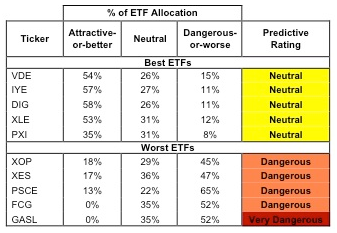
* Best ETFs exclude ETFs with TNA’s less than 100 million for inadequate liquidity.
Sources: New Constructs, LLC and company filings
PowerShares Dynamic Energy E&P (PXE) and Focus Morningstar Energy Index ETF (FEG) are excluded from Figure 1 because their total net assets (TNA) are below $100 million and do not meet our liquidity standards.
Figure 2: Mutual Funds with the Best & Worst Ratings – Top 5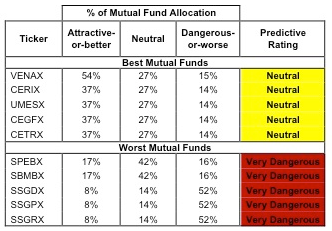
* Best mutual funds exclude funds with TNA’s less than 100 million for inadequate liquidity.
Sources: New Constructs, LLC and company filings
Five mutual funds are excluded from Figure 2 because their total net assets (TNA) are below $100 million and do not meet our liquidity standards.
Vanguard Energy ETF (VDE) is my top-rated Energy ETF and Vanguard World Funds: Vanguard Energy Index Fund (VENAX) is my top-rated Energy mutual fund. Both earn my Neutral rating.
Direxion Daily Natural Gas Related Bull 3x Shares (GASL) is my worst-rated Energy ETF and BlackRock Funds: BlackRock Energy & Resources Portfolio (SSGRX) is my worst-rated Energy mutual fund. Both earn my Very Dangerous rating.
Figure 3 shows that 56 out of the 279 stocks (42% of the total net assets) held by Energy ETFs and mutual funds get an Attractive-or-better rating. However, only 1 out of 20 Energy ETFs (less than 1% of total net assets) and 2 out of 76 Energy mutual funds (4% of total net assets) get an Attractive-or-better rating.
The takeaways are: Energy sector mutual fund managers and ETFs are picking the wrong stocks in this sector. Their fees are undeserved, no matter how low.
Figure 3: Energy Sector Landscape For ETFs, Mutual Funds & Stocks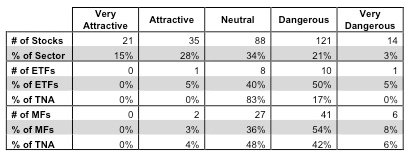
Sources: New Constructs, LLC and company filings
As detailed in “Cheap Funds Dupe Investors”, the fund industry offers many cheap funds but very few funds with high-quality stocks, or with what I call good portfolio management.
Investors need to tread carefully when considering Energy ETFs and mutual funds, as 95% of ETFs and 97% of mutual funds are not worth buying. Only 1 ETF and 2 mutual funds in the Energy sector allocate enough value to Attractive-or-better-rated stocks to earn an Attractive rating.
Western Refining, Inc (WNR) is one of my favorite stocks held by Energy ETFs and mutual funds and earns my Very Attractive rating. WNR’s return on invested capital (ROIC) of 20% places them in the 90th percentile of all Russell 3000 companies and demonstrates management’s ability to effectively allocate capital. And yet the market is bearish on the stock. WNR’s current stock price (~$23) implies that after-tax profits (NOPAT) will permanently decrease by 60%. Strong past performance coupled with the market’s overly pessimistic view of future performance makes WNR an excellent long candidate.
Carrizo OIL & Gas, Inc. (CRZO) is one of my least favorite stocks held by Energy ETFs and mutual funds and earns my Very Dangerous rating. CRZO has a long track record of value destruction. Not once in the 14 years I’ve covered the company has it generated an ROIC over its weighted average cost of capital (WACC). During the same period, the company has written off 20 cents for every dollar that had been invested in the business. In spite of its poor past performance, the market has optimistic future expectations. To justify its current stock price (~$23.41), CRZO must grow its profits by 15% compounded annually for 20 years. Lofty expectations and poor past performance offer investors a poor risk/reward trade-off here.
190 stocks of the 3000+ I cover are classified as Energy stocks, but due to style drift, Energy ETFs and mutual funds hold 279 stocks.
Figures 4 and 5 show the rating landscape of all Energy ETFs and mutual funds.
Figure 4: Separating the Best ETFs From the Worst ETFs 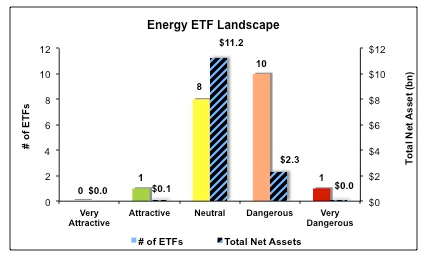
Sources: New Constructs, LLC and company filings
Figure 5: Separating the Best Mutual Funds From the Worst Mutual Funds 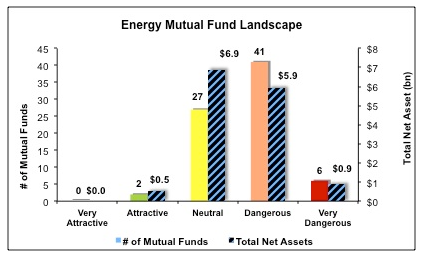
Sources: New Constructs, LLC and company filings
Disclosure: I own WNR. I receive no compensation to write about any specific stock, sector or theme
- English (UK)
- English (India)
- English (Canada)
- English (Australia)
- English (South Africa)
- English (Philippines)
- English (Nigeria)
- Deutsch
- Español (España)
- Español (México)
- Français
- Italiano
- Nederlands
- Português (Portugal)
- Polski
- Português (Brasil)
- Русский
- Türkçe
- العربية
- Ελληνικά
- Svenska
- Suomi
- עברית
- 日本語
- 한국어
- 简体中文
- 繁體中文
- Bahasa Indonesia
- Bahasa Melayu
- ไทย
- Tiếng Việt
- हिंदी
Best And Worst ETFs (And Mutual Funds): Energy Sector
Published 07/15/2012, 04:37 AM
Updated 07/09/2023, 06:31 AM
Best And Worst ETFs (And Mutual Funds): Energy Sector
Latest comments
Loading next article…
Install Our App
Risk Disclosure: Trading in financial instruments and/or cryptocurrencies involves high risks including the risk of losing some, or all, of your investment amount, and may not be suitable for all investors. Prices of cryptocurrencies are extremely volatile and may be affected by external factors such as financial, regulatory or political events. Trading on margin increases the financial risks.
Before deciding to trade in financial instrument or cryptocurrencies you should be fully informed of the risks and costs associated with trading the financial markets, carefully consider your investment objectives, level of experience, and risk appetite, and seek professional advice where needed.
Fusion Media would like to remind you that the data contained in this website is not necessarily real-time nor accurate. The data and prices on the website are not necessarily provided by any market or exchange, but may be provided by market makers, and so prices may not be accurate and may differ from the actual price at any given market, meaning prices are indicative and not appropriate for trading purposes. Fusion Media and any provider of the data contained in this website will not accept liability for any loss or damage as a result of your trading, or your reliance on the information contained within this website.
It is prohibited to use, store, reproduce, display, modify, transmit or distribute the data contained in this website without the explicit prior written permission of Fusion Media and/or the data provider. All intellectual property rights are reserved by the providers and/or the exchange providing the data contained in this website.
Fusion Media may be compensated by the advertisers that appear on the website, based on your interaction with the advertisements or advertisers.
Before deciding to trade in financial instrument or cryptocurrencies you should be fully informed of the risks and costs associated with trading the financial markets, carefully consider your investment objectives, level of experience, and risk appetite, and seek professional advice where needed.
Fusion Media would like to remind you that the data contained in this website is not necessarily real-time nor accurate. The data and prices on the website are not necessarily provided by any market or exchange, but may be provided by market makers, and so prices may not be accurate and may differ from the actual price at any given market, meaning prices are indicative and not appropriate for trading purposes. Fusion Media and any provider of the data contained in this website will not accept liability for any loss or damage as a result of your trading, or your reliance on the information contained within this website.
It is prohibited to use, store, reproduce, display, modify, transmit or distribute the data contained in this website without the explicit prior written permission of Fusion Media and/or the data provider. All intellectual property rights are reserved by the providers and/or the exchange providing the data contained in this website.
Fusion Media may be compensated by the advertisers that appear on the website, based on your interaction with the advertisements or advertisers.
© 2007-2025 - Fusion Media Limited. All Rights Reserved.
